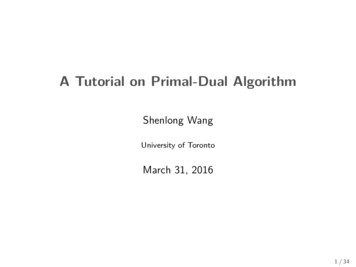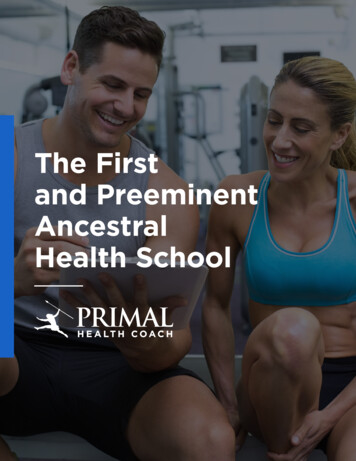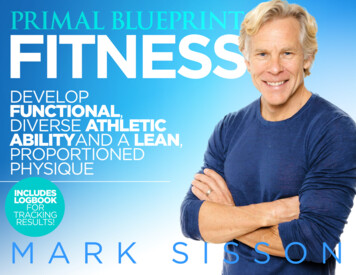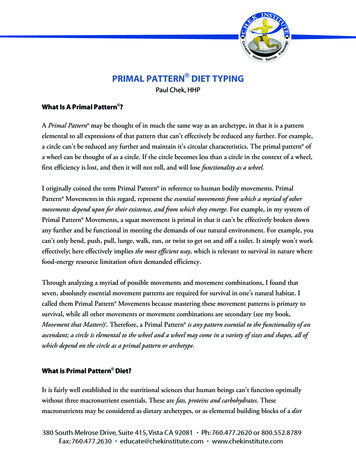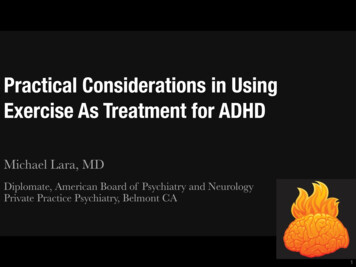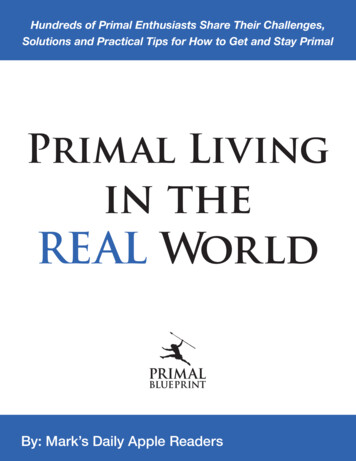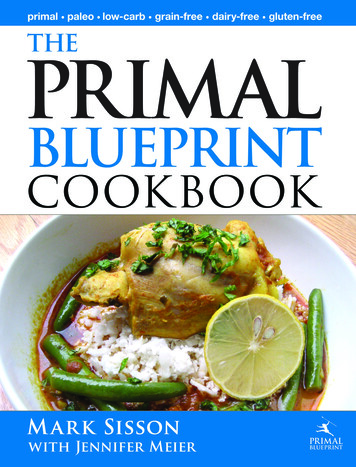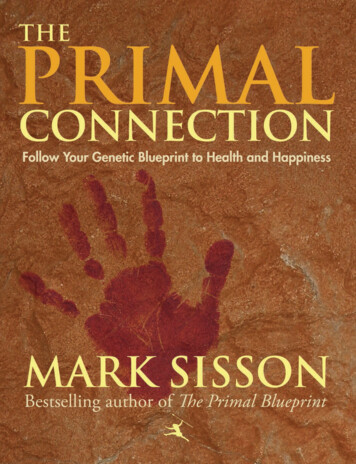
Transcription
THEPRIMALCONNECTIONMARK SISSONTHIS IS THE CHAPTER3
The Primal Connection 2013, Mark Sisson. All rights reservedExcept as permitted under the United States Copyright Act of 1976,reproduction or utilization of this work in any form or by any electronic,mechanical, or other means, now known or hereafter invented, includingxerography, photocopying, and recording, and in any information storage andretrieval system, is forbidden without written permission of Mark Sisson.Library of Congress Control Number: 2012920049Library of Congress Cataloging-in-Publication Data is on file with the publisherSisson, Mark, 1953–The Primal Connection: Follow Your Genetic Blueprint to Health and Happiness /Mark SissonISBN: 97809847551031. Self-help 2. Health&Fitness 3. Body, Mind & SpiritEditor/Project Manager: Jessica Taylor TudzinDesign/Layout and Illustrations: Caroline De VitaWriting/Research: Jennifer Zotalis, Brad KearnsCopy Editor: Nancy Wong BryanEditorial Assistant: Nancy Lehigh, Elizabeth KaneBack Cover Photo: Tahia HockingIndexing: Leoni McVeyContent and images on the Gokhale Method was sourced from 8 Steps toa Healthy Back with permission from the author, Esther Gokhale.For more information about the Primal Blueprint,please visit primalblueprint.com.For information on quantity discounts, please call 888-774-6259Publisher: Primal Blueprint Publishing.23805 Stuart Ranch Rd. Suite 145 Malibu, CA 902654THE PRIMAL CONNECTION
ContentsIntroduction9A Recipe For SuccessI21The Inner Dialogue Connection 39The Ten Habits ofHighly Successful Hunter-Gatherers 41IIThe Body Connection 73Stay in TouchGo Barefoot7479The Power of PostureMade to Move9098Section Summary105III The Nature Connection 107The Wild Within108Reclaiming the OutdoorsPlay Dirty117125Section Summary135TABLE OF CONTENTS5
IV The Daily Rhythm Connection 137Honoring the SunFinding Focus138158Slowing Down175Section SummaryV187The Social Connection 189The Inner Circle190Filling the Social WellbeingSection Summary203209VI The Play Connection 211Primal Play212The Play of ArtPrimal Thrills218224Section Summary235Author’s Note 237Endnotes 238Index 2446THE PRIMAL CONNECTION
DISCLAIMERThe ideas, concepts and opinions expressed in this book are intended tobe used for educational purposes only. This book is sold with the understandingthat author and publisher are not rendering medical advice of any kind, nor isthis book intended to replace medical advice, nor to diagnose, prescribe or treatany disease, condition, illness or injury. It is imperative that before beginningany diet or exercise program, including any aspect of the Primal Blueprintprogram, you receive full medical clearance from a licensed physician. Authorand publisher claim no responsibility to any person or entity for any liability,loss, or damage caused or alleged to be caused directly or indirectly as a result ofthe use, application or interpretation of the material in this book. If you objectto this disclaimer, you may return the book to the publisher for a full refund.DISCLAIMER7
8THE PRIMAL CONNECTION
IntroductionINTRODUCTION9
There is more wisdom in your body thanin your deepest philosophies.Friedrich NietzscheWELCOME TOTHE PRIMAL CONNECTIONAn advance notice: this is not a book about living a more gracious life. Noris it written to stir sentimentality or foster sophistication. On the contrary, it’san endeavor best undertaken with sleeves rolled up. Prepare to get your handsdirty. We’ll be digging down to the rudiments. It’s about unearthing somethingin ourselves that has been lost, buried, or obscured. It’s about reconnecting withthe less acknowledged, let alone less appreciated, layers of ourselves. It’s aboutgetting to the very essence of what makes us human and tapping into our geneticrecipe for health, happiness, and fulfillment.You see, I know many people who are by all normal measures of societyconsidered “successful.” In some cases, they have accomplished a great dealprofessionally. Many have families. All have a significant circle of close friends.Still, they often speak of a nebulous, hollow feeling. It’s as if something is missing,as if they have forgotten some important aspect of life somewhere along theway. They often describe a sense of emptiness, of not feeling truly connected—atleast not in the way that has them jumping out of bed to greet every day withenthusiasm. In many cases this void is nothing more than a minor distraction, asimple intuitive sense that maybe there’s something more to life, or maybe there’ssomething they’re not doing right.10THE PRIMAL CONNECTION
They try to fill the void in different ways: enrolling in a new class, attendingchurch, volunteering, or taking up philanthropy. You may relate. We arebombarded daily with magazines, TV shows, and self-help books offering plentyof “healthy living” directives—take this pill, take this vacation, take advantageof this special offer, run this 26.2-mile race, follow this eating regimen, and soon. While these suggestions can certainly help unburden the psyche, they failto address the core issue—just as taking a blood thinner fails to address theactual cause of a blocked artery. The emptiness goes deeper. It’s more innate,more instinctual, more organic. It’s something untapped.Many people take medications to better deal with the turbulent times—filling prescriptions for anxiety, depression, or insomnia—often for good reason,but in some cases with misgivings. Some seek out the advice of therapists or lifecoaches to help them. They delve into old memories, past intentions, trying toheal childhood wounds, all in hopes of feeling better, feeling more alive.In an age of distractions, relentless stress, strained relationships, andoveremphasized materialism, we often try to rationalize our way toward someprecipitous point of balance. We follow regimens. We manage our time andrelationships. We pencil in physical activities. We compartmentalize our needsand anxieties. For all the comforts and conveniences, the innovations andaccommodations, something about this whole picture of modern living isn’tworking for us. For all our knowledge, we impose an increasingly narrow, shallowdefinition on wellbeing.So, what makes for a healthy, grounded life, anyway? What does itgenuinely mean to thrive, to feel satisfied and fulfilled? We assume the answersare to be found in further progress: a new medication, a more elaborate gadget,the latest fitness class, or a social trend. The truth is, the answers we seek areoften not that complicated.What if it isn’t a failure of progress but the frustration of some unmet needat the cellular level? What if we entertain the notion that we aren’t—all of us as ahominid species—living the lives we were designed to live? Forget the caves andskins and matted hair for a minute. I’m talking about a life of physical challengebut ample leisure. I’m talking about living by the natural ebb and flow of lightand darkness, season to season. I’m talking about living in smaller groups. I’mtalking about play and creativity and getting dirt under our fingernails—a life ofthe raw senses and an overlapping of the self and the natural environment.INTRODUCTION11
I’ve been thinking about human health—researching and writing aboutit—for some thirty years now. My initial explorations into what it means to behealthy and fit centered on my own failings as an endurance athlete. I had blindlyfollowed conventional wisdom to sculpt myself into the most race-fit humanpossible, yet as I worked toward that goal I simultaneously became injured andill. “What’s wrong with this picture?” I asked myself.After an early forced retirement, I vowed to find ways to become thehealthy, strong, lean, and fit person I always wanted to be . but without havingto struggle and sacrifice so much to get there. I truly believed I could have itall, and that getting there did not have to be as difficult as most of us make itout to be. The convergence of modern genetic science and evolutionary biologyled me to an ancestral approach to health and fitness. A pattern emerged. If wecould eat and move like our ancestors did—within the context of a convenient,high-tech, and sometimes hedonistic twenty-first-century existence—thenwe would experience optimal health. It was as if our genes expect us to livea certain way, and we, through progress and convenience, have forgottenhow to do that.It makes intuitive sense that the foods our species has been eating over thelongest span of time are also the foods to which we are most highly adapted. Itmakes intuitive sense that the movements we’ve been performing for the longesttime are also movements which our bodies perform best and which elicit themost favorable hormonal responses or gene expression. After making a fewsimple adjustments to my diet and exercise routine, my health improved. Thisbecame the lifeway I started calling the Primal Blueprint, which I write aboutextensively on my blog, Mark’s Daily Apple.In researching and writing my 2009 book, The Primal Blueprint, I quicklybegan to grasp what I believe to be the single most empowering fact of our lives:that we all possess the genetic recipe to build a strong, lean, fit, happy, healthy,loving, productive, fulfilled human being. The process by which we each fulfillthat recipe, however, is largely up to the choices each one of us makes. Sure,some of us are taller, some bigger, some faster, some slightly more predisposed todiabetes or arthritis. Our parental genes determine such unchangeable variancesin our genetic makeup—they provide the range of possible outcomes within thebasic genetic recipe to build a human being. That basic recipe, however, is the samefor all of us. Each of us metabolizes food, stores and burns fat, builds muscle,12THE PRIMAL CONNECTION
heals wounds, and carries out almost every biological process using the samebiochemistry—it’s simply the degree to which our bodies do these things thatdetermines the difference.That diet and exercise are ways in which we can harness gene expression torebuild, renew, and regenerate ourselves every moment is obvious to me. But ina short time, I came to believe that there was much more to uncover. Maybe weare wired for happiness and contentment just as we are for fitness and health.I started thinking about sunlight, how I’d always felt better when I had a bit ofa tan going, and how sunny days are invariably happy days. Why is that? Maybethere was something happening to our neurochemistry as a result. Maybe itwasn’t just psychological.Thus began my exploration into how we live today and connecting it withresearch about our primal ancestors. As with diet and exercise, it seemed perfectlylogical that our bodies have come to expect certain environmental inputs suchas exposure to sunlight and darkness, both of which regulate our sleep habitsbased on millions of years of environmental pressures. (Ahh, so it was no smallcoincidence then that maintaining a modest year-round tan made me feelhealthy and happy.)From there, I began exploring how all the other environmental factors inour evolutionary ancestors’ lives may have shaped them . and us. As far as I wasconcerned, everything was fair game. What else could we learn from our ancestors’habitude? What more could we gain from understanding the evolutionary legacythat lives in each of us?Moving away from the trappings and stresses of modern life is one of, if notthe, key goal in the Primal Blueprint approach. However, when our relationshipwith our primal ancestors gets distilled into just how we diet and exercise, welose sight of that ultimate goal. Considering that our more advanced natureshave been evolving over some two million years, what else might our genesexpect from our environment? Specific sleep conditions? Certain models ofsocialization? Interaction with nature? Play? Beyond these questions of what,there’s the question of how these inclinations unfold in modern humans in amodern world. Are we meeting them? How do our innate expectations conflictwith our contemporary lifestyles?I began writing about environmental factors on Mark’s Daily Apple,comparing our ancestral settings and activities with those of today, citing currentINTRODUCTION13
and compelling research, and offering up concrete ideas for reclaiming—withmodern adaptations—pivotal elements of our primal origins.Readers told me I was opening up whole new dimensions to The PrimalBlueprint. It was becoming, in their encouraging words, a broader, deeper designfor them in achieving a richer, more fulfilling, as well as physically healthier life.I found the same benefits in living out these new principles, which I startedcalling the Primal Connection, in my own life. If we view every aspect of ourlives through an evolutionary lens, we find perspective in the choices we make.Often it provides more options—some quite surprising. The Primal Connection,I believe, can do for our psyches what The Primal Blueprint has done for manypeople’s physical health.Over the course of the last few years, readers have shared their stories ofimplementing the Primal Connection vision. And in no uncertain terms, theytold me they wanted more. Mark’s Daily Apple readers were the first to encourageme to write this book, and I thank them for the incredible enthusiasm andextraordinary insights that helped inspire it. This book is the culmination—anda reflection—of years of research and continuing conversations with readers andexperts in fields as diverse as medicine, psychology, anthropology, and neurology.The essential underlying premise of The Primal Connection journey is this:the more we live like our evolutionary ancestors, the healthier we are, the moreefficient our physiological functioning, the more normalized our hormonalresponses, the more health promoting our epigenetic storyline . and quite likely,the more content, satisfied, and fulfilled we can be. We’re about to discover andtap into the power of our genetic coding, what I like to call our factory settings,to understand and exploit (with practical modern adaptation) the defaultexpectations genetically developed over the arc of our evolutionary history. Theconcept of ancestral archetype makes intuitive—even elegant—sense. It alsobears out under the harsh light of scientific inquiry. There’s no proposal in thisbook that doesn’t jibe with contemporary research.You will notice a few recurring themes as this book unfolds. The first is thatour genes expect certain inputs and behaviors from us. When we generally “stickto the script” and provide the kinds of inputs our genes have evolved to expectover millennia, they get the signal to build or to regenerate us as healthy, strong,happy people. That’s what our DNA recipe calls for. When we don’t provide theexpected inputs, our genes still take action, but in this case are often signaled to14THE PRIMAL CONNECTION
take steps to protect us from short-term harm in ways that compromise longterm health. For example, we carry around excess body fat because our genes—forged in a crucible of carbohydrate scarcity—now experience carbohydrateoverabundance. This causes our fat-storing, sugar-burning genes to up-regulate,and our fat-burning genes to down-regulate. Type 2 diabetes, then, isn’t so muchan example of weak or defective genes as it is a condition wherein our perfecthuman genes are attempting to protect us from an excess sugar intake and alifetime of poor diet and exercise choices.This brings us to the second theme: we live in a world where abundanceand scarcity are often mismatched with what our genes expect. We now haveabundant access to all sorts of sugars (grains, alcohol, refined sugar, and fruityear-round), comforts and conveniences (electricity, automobiles, refrigeration,climate control, digital gadgets, and so forth), and instant and passive gratification(drugs, porn, reality TV, Facebook, and so on). All this was either extremelyscarce or completely nonexistent until most recently in our evolutionary timeline.On the flip side, what was once abundant—leisure time, participation innature, sun exposure, natural sound cues, for example—is now scarce. If wedo bring these things into our lives, it’s now by conscious, deliberate choice.Naturally, problems arise as a result of these mismatches, affecting our genes,hormones, neurotransmitters, receptors, and other biological processes thatwere all originally developed under the selection pressure of scarcity and threatof death. Though the primitive threats to our survival no longer exist in mostplaces on the globe today, our genetic hardwiring still expects—and actuallyappreciates—a certain measure of scarcity for some things and a certain measureof abundance for others.The third theme you will see throughout this book is what I call “chasingthe high.” That is, making choices that seem like a good idea at the time, butultimately backfire to our detriment. I’m referring to self-stimulating ourinnate, survival-driven, feel-good hormonal reward system to the point ofexcess or addiction, usually the result of overindulging in stimuli that oncewere exceptionally scarce or nonexistent. We might overeat carbs for quickenergy and a pulse of serotonin, or become addicted to drugs, sex, gambling,texting, or even long-distance running for the feel-good endorphins andopioids. Each time we are rewarded, we come back for more. We aren’tat all unlike Pavlov’s dogs in that regard. It indeed behooves us to engageINTRODUCTION15
our higher-level reasoning and evaluate the long-term consequences ofshort-term gratification.But let’s be perfectly clear. I’m not advocating a return to the caves, and,for the record, I’m not out to confiscate anyone’s iPhone. This is not aboutabandoning modern society or donning skins and living in the wilderness. (Ifthat’s your thing, however, go for it.) The Primal Connection is about infusingour modern lives with the best and most reasonably reclaimed elements of ourevolutionary past, including time outdoors, all-consuming play, human touch,and deeper social connections, for the simple purpose of making us happier,healthier, and well adjusted. It’s about simplifying, stripping away layers ofcomplexity, giving yourself a break, reframing your perspective, and loweringyour stress levels by acting, breathing, moving, and thinking in ways thatpromote optimal gene expression. There is no requirement to master intensivestudy topics, allocate massive amounts of time to a long list of daily to-do items,or eschew most of the pleasures and comforts we enjoy in modern life. You willsee plenty of suggestions and directives to implement each connection, butpersonal preference, and your own sense of what resonates, will dictate howyou express them. What’s key is that your intention—and your will to takeaction—is pure. But before you jump in, let’s take a look at the connectionsyou are about to explore:The Inner Dialogue Connection. This section will address ourinner chatter—the monologues, diatribes, and even full dialogueswe carry on within our heads. The majority of the monkey chatterwe manufacture in our minds is negative self-talk: obsessing aboutsuperficial concerns, worry over the imagined outcome of events thathave yet to (and likely may never) happen. In the Inner DialogueConnection, you will learn the 10 Habits of Highly Successful Hunter-Gatherers,including taking responsibility for your life, being present, trusting your gut,mastering your skills, and redefining your concept of affluence.The Body Connection. In this section, you will learn how the silent, potentlanguage of human touch positively affects us on the biochemical level, providingcomfort and healing. You’ll learn why wearing shoes can cause lower back pain,skewed postural alignment, and impaired hip mobility, and how going barefoot will16THE PRIMAL CONNECTION
not only reduce or eliminate such ailments, but help build a strongAchilles tendon and improve your posture. Speaking of which, didyou know that a J-shaped spine is more natural to the human formthan the S-shaped spine promoted by conventional wisdom? We’lllook closer at the biomechanics of posture and moving, and discusswhy taking frequent breaks and moving frequently throughout the day providesmore health benefits than just a single one-hour daily workout.The Nature Connection. You’ll find that spending time in natureis not just a refreshing sensory escape, but a necessary balance tothe distractions of the modern world. Even if you’re firmly rooted inan urban jungle, you can give your genes the nature experience theyexpect, even if that means some of it is simulated through imageryand recorded sounds. And you’ll learn to express your primal need toclaim your habitat by navigating your home surroundings on foot. You’ll learn whygetting dirty—through gardening or having a mud fight with the neighborhoodkids—can dramatically boost mood, cognition, and immune function (and whyyou will want to temper your clean-freak tendencies).The Daily Rhythm Connection. For more than 2.5 millionyears of human history, the solar sequence of daybreak and nightfallhas indelibly imprinted our gene pattern with hormone andbiochemical releases that trigger our sleep, wakefulness, and activitylevels. Our conquest over light and dark with artificial illumination overrides thisnatural circadian rhythm. To accommodate to the constructs of society, day andnight are now contrived lengths, demanding of us shorter sleep cycles and longerperiods of wakefulness. Add the barrage of media, technology, and communicationthat must be filtered and managed today, and our already distorted, biologicalcadence is decidedly off-tempo, degrading our health and wellbeing. You will learnways to counteract the data storm, reset your circadian clock to a closer replica ofyour genetic model, and slow down.The Social Connection. We are all looking for ways to maximize qualitytime with our closest friends and family in the midst of the daily demands thatare placed on us. This section will discuss the health benefits of building andINTRODUCTION17
maintaining close social ties, consider the influx of social media,and question if we are hardwired to interact within small groupsrather than manage larger groups numbering in the hundreds.You will be challenged to look at the superficial connections thateat away at your time and energy, and reassess and prioritize thepeople of most importance in your life. And finally, you will learn ways to walkthrough the mindless electronic chatter to more personal, peaceful, and satisfyingsocial relationships.The Play Connection. The need for play doesn’t go awayas we grow up; it actually becomes more necessary the morecomplex our lives become. Play was a vital part of primallife, helping our ancestors experiment, problem solve, andincrease knowledge without having to face real-life (or death!)pressures. True play is commonly neglected these days in favorof artificial, leisure-time fillers—computer, TV, digital games, Facebook—that do little or nothing toward refreshing or re-orienting us, or enriching ourrelationships. The innocent fun of childhood can be ours again, especially withoutdoor activity. Adult playtime will help break you out of your regimenteddaily routine and awaken your creativity and fun-loving spirit. We’ll explore araft of artistic and athletic possibilities to consider.At this time, I’d like to make the ambitious assumption that you are familiarwith the Primal Blueprint philosophy as it relates to the basics of eating andexercise. As we venture beyond what’s on your dinner plate to discuss thethoughts in your head, the feelings in your heart, and the social customs of dailylife as they relate to optimal gene expression, I must assert that the gatewaythis book offers to happiness and contentment will be more easily accessibleif you are practicing the movement’s basic principles. If you are falling shortof optimal eating and exercise, it’s best to take a few steps back and acquaintyourself with the basics before contemplating the higher levels of awarenessoffered in this book.18THE PRIMAL CONNECTION
THE PRIMAL BLUEPRINT DIETAND EXERCISE AT A GLANCEEat Primal Foods. Meat, fish, fowl, eggs, vegetables, fruits, nuts, and seeds are nutritious, highly satisfying, and promote stabilized energy levels and efficient burning ofstored body fat for energy.Ditch Toxic Modern Foods. The excessive intake of processed carbohydratesand chemically altered fats in the Standard American Diet (SAD) may be themost health-destructive element of modern life. Excess insulin production from ahigh-carbohydrate diet leads to burnout, fatigue, disease, lifelong weight gain, anda continued dependency on additional health-compromising carbs! Eliminate thefollowing SAD staples: Sugars and sweetened beverages: Consumption of processed sweetsthat our genes are not accustomed to promotes wildly excessive insulinproduction, suppresses immune function, and accelerates aging. Grains: Wheat, corn, rice, cereal, pasta, and all derivatives such as breads,crackers, energy bars, breakfast staples, pizza, chips, cooking grains, andpackaged snacks. Yep, even whole grains are troublesome, stimulatingexcessinsulin production and containing antinutrients that compromisedigestion and immune function. vegetable oils: These promote free-radical damage and accelerate aging.Toss them out and stick with butter for cooking. processed and packaged foods: If it’s in a box or a wrapper, far from astate found in nature, think twice.Exercise Primally. An increase in everyday activity—including low-intensityaerobic workouts (walking, hiking, easy cycling, cardio machines, jogging) andintense (but brief) sprints and strength training—will optimize fat metabolism,delay the aging process, build and maintain lean muscle mass, and develop lifelongfunctional fitness. Avoid the prevailing chronic approach to exercise, where workoutsare too hard, too lengthy, too frequent, and do not allow sufficient rest in between.With the Primal approach, maximum results can be achieved with minimal timeand suffering!INTRODUCTION19
20THE PRIMAL CONNECTION
A Recipe For SuccessAs a product of millions of years of evolutionary design, you are hardwiredto feel good. When our evolutionary ancestors ate, slept, touched, loved, hunted,and played, they were rewarded with the release of adaptive “feel good” hormonesand neurotransmitters—oxytocin, dopamine, endorphins, and serotonin, toname a few. Repeating behaviors that made us feel good advanced the goalsof evolution—that is, to survive and pass on our genetic material to the nextgeneration. Genetically speaking, we are still identical to our hunter-gathererancestors so these behaviors remain universal. Though we are unchanged, ourworld is not. Scarcity has given way to overabundance, and vice versa. As a result,instead of facing the selection pressures of predators and starvation, our dangernow lies in self-stimulating our feel-good hormones by artificial or excessivemeans. Indeed, our innate reward system can either act to our detriment whenwe abuse it, or act as an inner compass that can lead us toward better health,peace of mind, short-term pleasure, and long-term happiness.A RECIPE FOR SUCCESS21
The genes are the bricks and mortar to build a brain.The environment is the architect.Christine HohmannNeuroscientistHARDWIRED FORFEEL-GOOD HORMONESWe humans are hardwired to pursue pleasure. No doubt, you’ve long beenaware that whenever you exercise, eat nutritious food, have sex, spend time innature, align your sleep habits with the sun, and foster supportive relationships,you feel pretty darn good. You feel energized, positive, excited, motivated,loving, powerful, fulfilled, and happy. This built-in reward system representsthe essence of survival. It acts as an inner compass that guides you to pursuesocial, geographical, cultural, nutritional, and physical behaviors that rewardon a biochemical level, all the way from such basic needs as acquiring shelter,food, and safety, on up the list to more refined endeavors such as ponderingethical dilemmas, pursuing creative outlets, and engaging high-level reasoning.Fact is, whenever we do anything that confers a survival benefit to our species,we reinforce ancient neural pathways and produce feel-good hormonesand neurochemicals.Of course, this flies in the face of the behaviorist school of thought, whichoperates on the implicit assumption that we come into this world as “blankslates,” empty pages upon which we personally compose our life narratives. Yes,22THE PRIMAL CONNECTION
it’s true that we make an infinite number of active and (hopefully) consciouschoices that help direct our life’s course. Yet, as evolutionary psychologist StevenPinker and other scientific experts tell us, that’s only part of the story.We come into this world as products—and bearers—of millions of yearsof evolutionary design. Many of the attributes, motivations, and anxieties thatcharacterize our individual lives today have their roots in experiences fromthousands, even millions, of years ago. These are what I refer to throughout thisbook as the expectations of our hunter-gatherer genes—the DNA “recipe” fora healthy, fit, happy, loving human. There are certain inputs our Homo sapienssapiens genes anticipate and expect based on evolution. When we don’t providethose inputs, we develop disconnects that can lead to disease and depression.“Many of the attributes, motivations,and anxieties that characterize ourindividual lives today have their rootsin experiences from thousands, evenmillions, of years ago.”The long road of evolution shaped how our bodies developed—walkingupright and having opposable thumbs, for instance. It also shaped how our brainsdeveloped and, with it, the emotional states and cognitive heights we’re capableof experiencing. In recent years, with the study of epigenetics, we’ve begun lookingat h
For more information about the Primal Blueprint, please visit primalblueprint.com. For information on quantity discounts, please call 888-774-6259 Publisher: Primal Blueprint Publishing. 23805 Stuart Ranch Rd. Suite 145 Malibu, CA 90265



